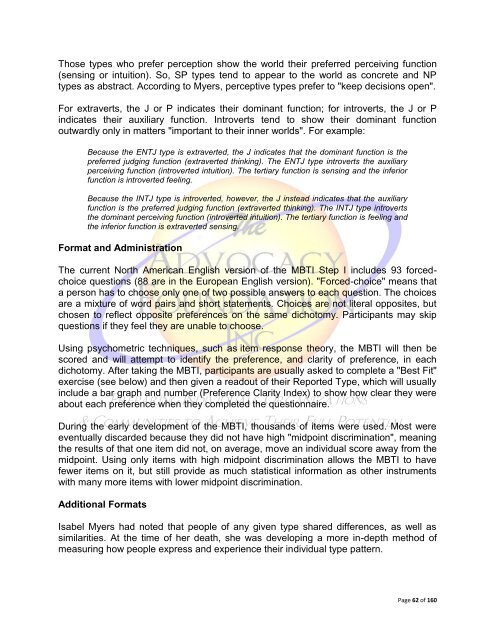The Gift of Introversion
The Gift of Introversion
The Gift of Introversion
You also want an ePaper? Increase the reach of your titles
YUMPU automatically turns print PDFs into web optimized ePapers that Google loves.
Those types who prefer perception show the world their preferred perceiving function<br />
(sensing or intuition). So, SP types tend to appear to the world as concrete and NP<br />
types as abstract. According to Myers, perceptive types prefer to "keep decisions open".<br />
For extraverts, the J or P indicates their dominant function; for introverts, the J or P<br />
indicates their auxiliary function. Introverts tend to show their dominant function<br />
outwardly only in matters "important to their inner worlds". For example:<br />
Because the ENTJ type is extraverted, the J indicates that the dominant function is the<br />
preferred judging function (extraverted thinking). <strong>The</strong> ENTJ type introverts the auxiliary<br />
perceiving function (introverted intuition). <strong>The</strong> tertiary function is sensing and the inferior<br />
function is introverted feeling.<br />
Because the INTJ type is introverted, however, the J instead indicates that the auxiliary<br />
function is the preferred judging function (extraverted thinking). <strong>The</strong> INTJ type introverts<br />
the dominant perceiving function (introverted intuition). <strong>The</strong> tertiary function is feeling and<br />
the inferior function is extraverted sensing.<br />
Format and Administration<br />
<strong>The</strong> current North American English version <strong>of</strong> the MBTI Step I includes 93 forcedchoice<br />
questions (88 are in the European English version). "Forced-choice" means that<br />
a person has to choose only one <strong>of</strong> two possible answers to each question. <strong>The</strong> choices<br />
are a mixture <strong>of</strong> word pairs and short statements. Choices are not literal opposites, but<br />
chosen to reflect opposite preferences on the same dichotomy. Participants may skip<br />
questions if they feel they are unable to choose.<br />
Using psychometric techniques, such as item response theory, the MBTI will then be<br />
scored and will attempt to identify the preference, and clarity <strong>of</strong> preference, in each<br />
dichotomy. After taking the MBTI, participants are usually asked to complete a "Best Fit"<br />
exercise (see below) and then given a readout <strong>of</strong> their Reported Type, which will usually<br />
include a bar graph and number (Preference Clarity Index) to show how clear they were<br />
about each preference when they completed the questionnaire.<br />
During the early development <strong>of</strong> the MBTI, thousands <strong>of</strong> items were used. Most were<br />
eventually discarded because they did not have high "midpoint discrimination", meaning<br />
the results <strong>of</strong> that one item did not, on average, move an individual score away from the<br />
midpoint. Using only items with high midpoint discrimination allows the MBTI to have<br />
fewer items on it, but still provide as much statistical information as other instruments<br />
with many more items with lower midpoint discrimination.<br />
Additional Formats<br />
Isabel Myers had noted that people <strong>of</strong> any given type shared differences, as well as<br />
similarities. At the time <strong>of</strong> her death, she was developing a more in-depth method <strong>of</strong><br />
measuring how people express and experience their individual type pattern.<br />
Page 62 <strong>of</strong> 160

















